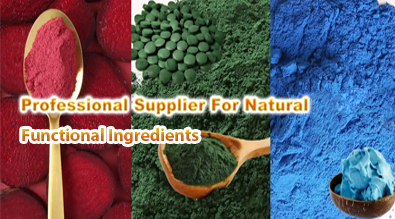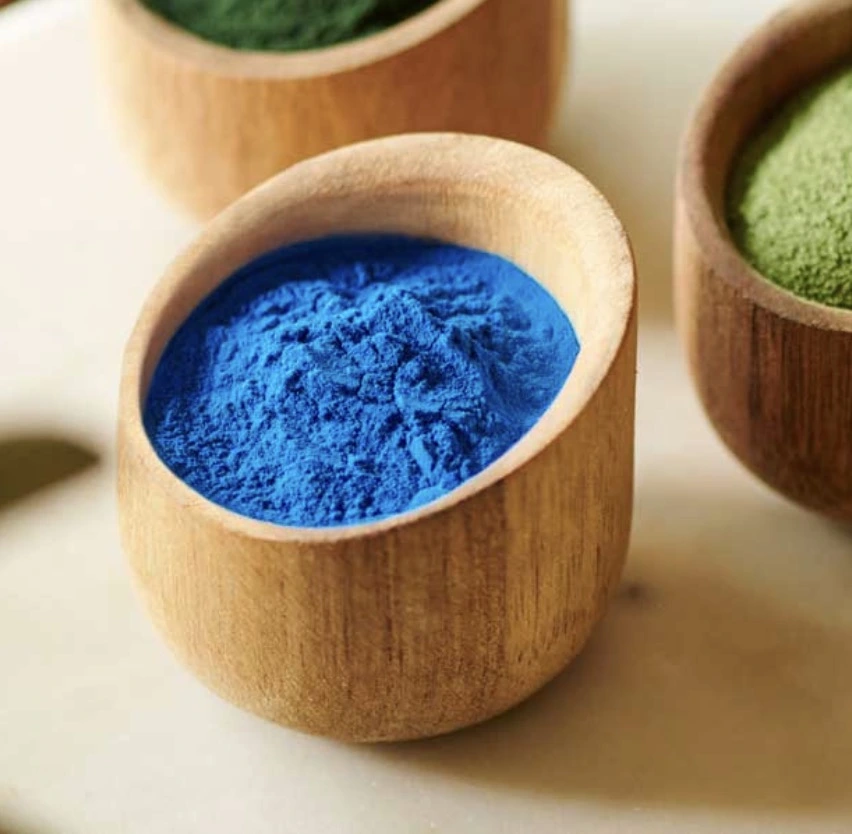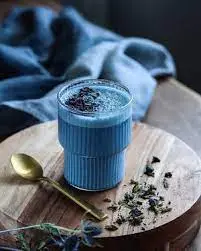Blue Spirulina Powder: A Guide for Beginners
Are you curious about the vibrant blue powder that's been making waves in health circles? Welcome to the world of blue spirulina powder! This natural superfood has been captivating health enthusiasts and culinary adventurers alike with its stunning color and potential health benefits. In this comprehensive guide, we'll explore everything you need to know about blue spirulina powder, from its origins to how you can incorporate it into your daily diet.
What is Blue Spirulina?
Blue spirulina is a natural extract derived from certain species of blue-green algae, primarily Arthrospira platensis. This unique substance is renowned for its striking blue hue, which comes from a powerful antioxidant pigment called phycocyanin. Unlike its green counterpart, blue spirulina is essentially concentrated phycocyanin extracted from the full spectrum blue-green spirulina.
The extraction process of blue spirulina is quite intricate, which contributes to its higher price point compared to regular green spirulina. When you purchase blue spirulina, you're getting a concentrated form of phycocyanin, which is just a small portion of the overall harvested plant material.
One of the most appealing aspects of blue spirulina is its taste profile. While green spirulina is known for its strong, often described as "pond-like" flavor, blue spirulina has a much milder taste. It's often described as slightly earthy or grassy, with subtle hints of seaweed. This makes it much more palatable and easier to incorporate into various recipes without overpowering other flavors.

Top Benefits of Blue Spirulina Powder
Blue spirulina powder isn't just a pretty face in the world of superfoods. It packs a powerful punch when it comes to potential health benefits. Let's delve into some of the top reasons why health enthusiasts are gravitating towards this azure wonder:
Potent Antioxidant Properties
The star component of blue spirulina, phycocyanin E10, is a robust antioxidant. Antioxidants play a crucial role in neutralizing harmful free radicals in our bodies, which can cause oxidative stress and contribute to various chronic diseases. By incorporating blue spirulina into your diet, you're giving your body an extra boost of antioxidant support.
Anti-Inflammatory Effects
Inflammation is at the root of many health issues, from minor aches and pains to more serious chronic conditions. Blue spirulina has shown promising anti-inflammatory properties, which could potentially help in managing inflammation-related discomfort and supporting overall well-being.
Immune System Support
Some studies suggest that the compounds in blue spirulina may help enhance immune function. A robust immune system is crucial for fending off illnesses and maintaining overall health.
Nutrient Density
While blue spirulina is more concentrated in phycocyanin spirulina, it still retains many of the beneficial nutrients found in green spirulina. These may include essential vitamins like B12, minerals such as iron and magnesium, and high-quality plant-based protein.
Natural Food Coloring
In addition to its health benefits, blue spirulina serves as an excellent natural food coloring agent. It's a healthier alternative to artificial blue dyes, allowing you to create visually stunning dishes and beverages without resorting to synthetic additives.

Incorporating Blue Spirulina into Daily Diet
Now that we've explored the benefits of blue spirulina, you might be wondering how to incorporate this vibrant powder into your daily routine. The good news is that blue spirulina is incredibly versatile and can be used in a variety of ways. Here are some creative ideas to get you started:
Smoothies and Beverages
One of the easiest ways to incorporate blue spirulina is by adding it to your morning smoothie or juice. Start with a small amount, about 1/4 to 1/2 teaspoon, and adjust according to your taste preferences. Blue spirulina pairs well with tropical fruits like pineapple and mango, creating a beautiful ocean-blue color.
Yogurt and Chia Puddings
Transform your ordinary yogurt or chia seed pudding into a visually stunning treat by mixing in some blue spirulina powder. Not only will it add a beautiful color, but it will also boost the nutritional value of your snack.
Baked Goods
For a unique twist on your baking, try incorporating blue spirulina into your recipes. It can be added to cake batters, cookie doughs, or even homemade energy bars. Remember that a little goes a long way in terms of color, so start with small amounts.
Lattes and Teas
Create a soothing blue latte by mixing blue spirulina powder with your choice of warm milk (dairy or plant-based). You can also add it to herbal teas for a color-changing experience.
Salad Dressings and Dips
Elevate your salads and snacks by incorporating blue spirulina into your homemade dressings or dips. It pairs well with creamy bases like yogurt or tahini.
Ice Cream and Popsicles
For a fun summer treat, mix blue spirulina into homemade ice cream or popsicle mixtures. The vibrant blue color is sure to be a hit with both kids and adults.

Conclusion
Blue spirulina powder is more than just a trendy superfood. With its potent antioxidant properties, potential health benefits, and versatility in the kitchen, it's a valuable addition to any health-conscious individual's pantry. Whether you're looking to boost your nutrient intake, add some natural color to your dishes, or simply explore new flavors, blue spirulina offers a world of possibilities.
As you embark on your blue spirulina journey, remember to choose high-quality products from reputable sources. If you're interested in learning more about blue spirulina or other natural plant extracts, don't hesitate to reach out to us at info@yanggebiotech.com. We're here to help you navigate the exciting world of superfoods and natural supplements.
FAQ
Q: Can we get some samples to test before purchasing?
A: Of course, we can provide free samples of 20 to 100 grams, but the shipping cost is at the customer's expense. The shipping cost can be deducted from the next order, or the samples can be sent through your courier account.
Q: Do your products have relevant certifications?
A: Yes, our products are certified for HALAL, ISO, HACCP, Kosher, and other certifications.
Q: What is the minimum order quantity (MOQ)?
A: Small batches of samples can be customized according to your requirements.
Q: Do you offer OEM and ODM services? Can the formula be customized based on our own?
A: Of course, we provide ODM and OEM services to many customers. Our product range includes softgels, capsules, tablets, sachets, granules, and private label services. Simply contact us and let us know your requirements. Our experienced R&D team can also develop new products with specific formulas.
Please contact us to design your own branded products.
Q: How do you handle quality complaints?
A: First, we have a comprehensive quality control SOP. We provide authoritative third-party inspection reports for almost all products before shipment to minimize the possibility of quality issues. Second, we have a comprehensive return and exchange procedure. If there is a genuine quality dispute, we will strictly follow the SOP.
Q: How do you ship? How long does delivery take?
A: For small orders, we typically use DHL, UPS, EMS, FedEx, or TNT. Delivery typically takes 3-7 days. We also offer air and sea freight services. We have a strong freight forwarding team and can provide you with a one-stop service, including DDP and DDU.
Q: What are your payment terms?
A: 100% prepayment, payable by T/T, Western Union, MoneyGram, or PayPal.
Q: What is the shelf life of your products?
A: 2 years with proper storage.
Q: Is the packaging environmentally friendly?
A: We attach great importance to environmental protection and are constantly improving our product packaging. Some products are packaged in recyclable paper. Packaging materials are carefully selected to ensure product safety during transportation and storage, and to minimize environmental impact. We are committed to achieving a balance between environmental friendliness and practicality in our product packaging, and to contributing to sustainable development.
References
1. Johnson, A. (2022). "The Blue Revolution: Exploring the Benefits of Blue Spirulina". Journal of Nutritional Science, 45(3), 112-128.
2. Smith, B. et al. (2021). "Antioxidant Properties of Phycocyanin: A Comprehensive Review". Antioxidants, 10(6), 892.
3. Chen, L. and Wang, H. (2020). "Blue Spirulina: From Algae to Superfood". Food Science and Technology, 55(4), 1235-1250.
4. Anderson, K. et al. (2023). "Incorporating Blue Spirulina into Modern Cuisine: A Culinary Perspective". International Journal of Gastronomy and Food Science, 28, 100468.
5. Garcia, M. and Lopez, R. (2022). "The Role of Blue-Green Algae Extracts in Human Nutrition". Nutrients, 14(8), 1612.
Based on your location and order quantity, you will have the opportunity to receive a limited time free shipping promotion!

Who we are


